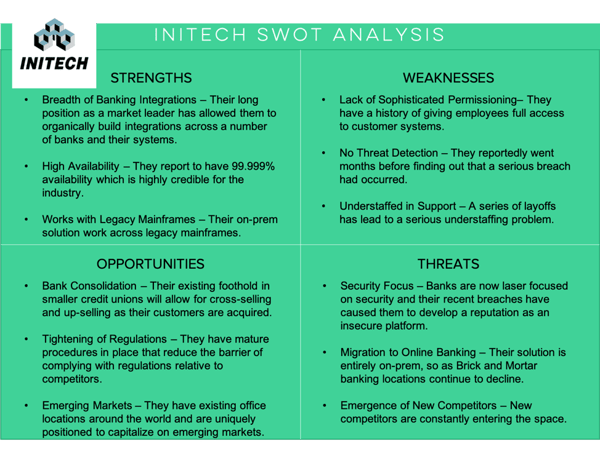Giving your company a competitive advantage requires ongoing assessment and strategic planning. One way to evaluate your company's performance is through SWOT analysis. A SWOT analysis includes gathering accurate, fact-based data that gives you an overview of your company's strengths, weaknesses, opportunities, and threats, that affect your business performance.
A SWOT analysis is definitive because it’s based on actual data and not conjecture. For this reason, you should use a SWOT analysis as a guide for refining your current strategy or adopting a new approach. Let’s dive in and take a look at how to conduct a SWOT analysis and how you can leverage it for your business.
What is SWOT Analysis?
Let’s start with the basics of a SWOT analysis. A SWOT analysis consists of four target areas - strengths, weaknesses, opportunities, and threats.
Download our Free Competitive Analysis Template
Strengths highlight assets or qualities that put you ahead of others in the market. For instance, you may have developed a strong brand, established your demographic, have a unique product feature, or you are viewed as an innovator.
Weaknesses are components in your business that are hindering you from maintaining a competitive advantage. These could include outdated manual processes, ineffective marketing strategies, lack of capital, or missing piece in your product that would address your market’s pain points.
Opportunities are prospects, openings, or breaks that your company can take advantage of right now to put you ahead of the competition. This could include deregulation in your industry, new advances in technology, or a popular trend in culture.
Threats may include any risk that could harm your organization. The threat can be internal or external. For instance, an employee could share a trade secret, the economy could take a downturn, or a new competitor just received a lot of attention for a groundbreaking idea.
How to Conduct a SWOT Analysis
The success of a SWOT analysis depends on your ability to identify factors that can impact your business. It’s not about pinpointing your prediction as much as it is knowing what you should expect and plan for.
With that in mind, here are some things to consider when conducting a SWOT analysis:
Build Your SWOT Team
The best way to assemble your team is to handpick individuals whose experience, role, and knowledge most closely align with your SWOT objectives.
Your team can consist of stakeholders, board members, executives, employees, business partners, or even customers. The more feedback you gather from your analysis, the better you can establish your SWOT.
Establish a Purpose or an Objective
What is the purpose of your SWOT analysis? What specific data are you trying to gather and assess? Knowing what your objective will help you determine precisely what to look for during your research.
For instance, you may want to conduct a SWOT analysis to help you determine if you should introduce a product, add a new department, or relocate your business. A SWOT analysis can also help you decide whether you need to outsource specific processes or make a digital transformation in a particular part of your business. A SWOT analysis provides enough flexibility so that you can use it to assess several areas across your organization.
Conduct Thorough Research
Conducting research gives you a greater understanding of your business, your industry, and your market. It provides the basis for identifying your strengths, weaknesses, opportunities, and threats.
You’ll want to conduct unbiased research about where your company stands across all departments. Be honest with where your weaknesses are, because if you don’t, you’re only hurting your own business strategy. You also want to be sure you’re honest about where your strengths are. While every business may believe they’re the best in the industry, it’s important to remember there is always room for improvement and more importantly, there will always be new competitors popping up in your market.
Without in-depth research, you can’t gauge your competition or your ability to maintain your competitive advantage. So, once you establish your objective, conduct as much research as you can.
List Your Strengths, Weaknesses, Opportunities, and Threats
Make a grid with four squares, or download this free template to get started. Each square represents the four elements of your SWOT analysis. Gather your information, condense it into short sentences, and put each item in the right category so that you can visualize the elements of your SWOT. Focus on the strengths and weaknesses that come up the most in your research, because these are likely the most impactful and true to your business. And, focus your opportunities and threats on those that have the highest potential impact on your business.
Here is an example of a SWOT analysis for Initech. Here you can see that they’ve put three key bullet points in each of the four categories. This allows them to visualize where they are successful, where they need to improve, new opportunities for them in the market, as well as what’s potentially threatening their business.

How to Leverage Your SWOT Analysis for Your Business
Anytime you perform an assessment of your business performance, you need to be prepared to act on your findings. Otherwise, your analysis is a waste of everybody’s time.
There are a few main key action items for each piece of your SWOT analysis. For your strengths and opportunities, you want to take advantage of them and leverage them to benefit your company growth. For your weaknesses and threats, you want to figure out how to downplay them and prepare your company to tackle the market threats. Below are some steps you can take to develop your SWOT action plan.
- Review each SWOT category and prioritize your list. What does your team need to address right now? What requires long-term planning? You may want to prioritize your action items according to how they affect your productivity, revenue streams, marketing campaigns, customer service, or competitive edge.
- Make sure your action items are tangible and measurable. For instance, instead of saying that you are going to improve communications within your departments, make a list of how you are going to improve your communications – i.e., switching to VoIP telephones, simplifying your processing, or utilizing a cloud platform. During this stage, you should also set goals or KPIs of what you hope the end result to be. These present you with opportunities for measuring the success of your objective.
- Delegate the management of each action item to one person on your team. Meet with this person to go over action items, benchmarks, and your measurable goals. Make sure this person naturally aligns with the goal, can manage it, and has the buy-in.
- Create a timeline for action launch and completion. Break your timeline up into benchmarks so that everyone can observe the progress of the action item. Creating a timeline guarantees that your SWOT will go from the conference room to implementation.
Your company's strengths and weaknesses are your internal factors, and opportunities and threats are the external factors that impact your company. By analyzing both internal and external factors that impact your business through a SWOT analysis, you will be able to strengthen your internal strategies and strategically position yourself against your competition.




